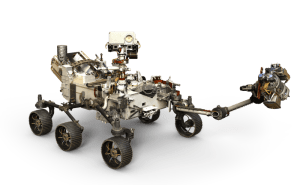Teledyne Acton Optics UV lenses and mirrors were incorporated into aspects of the remote sensing instrument, SHERLOC, to begin the search for microbial life on Mars.
New Jersey, USA – Teledyne Princeton Instruments, a Teledyne Technologies [NYSE:TDY] company, and world-renowned manufacturer of scientific imaging and spectroscopy equipment, is pleased to announce that Teledyne Acton Optics UV lenses and mirrors were incorporated into the SHERLOC UV Spectrometer module, a remote based sensing instrument, on board NASA’s Mars Rover Perseverance, which launched on July 30th at 07.50 Eastern Time.

NASA’s Mars 2020 mission is the next instalment of the long-term effort to robotically explore Mars. This mission addresses current high-priority scientific goals, including trying to answer the question of whether there are signs of past microbial life on the planet.
By studying an astrobiologically relevant ancient environment on Mars, the Perseverance aims to investigate its history and surface geological processes, including whether it may have been habitable, to assess the possibility of previous life on the planet. The Perseverance will also determine whether it is possible that biosignatures have been preserved within accessible geological materials. In addition, the Perseverance will gather knowledge and demonstrate technologies to assess potential challenges that may be associated with future human expeditions, such as the testing of an oxygen producing method, and the characterization of environmental conditions.
Teledyne Acton Optics, part of Teledyne Princeton Instruments, provided key optical components of the SHERLOC UV spectrometer. These included lenses and mirrors incorporated into the Conditioning Optics Modules of the system, lenses for the Context Imager Lens Assembly, and broadband mirrors for the Spectrometer Module. SHERLOC is mounted onto the arm of the Perseverance and uses both Raman and luminescence spectroscopy to search for minerals and organics that have been altered by watery environments, indicative of potential past microbial life.
In addition to Teledyne Acton Optics, Teledyne e2v provided a CCD42-10 sensor for the SuperCam and SHERLOC instruments on the Perseverance to aid the search for organic compounds and minerals, and to see if there has been any water based influence on the environments, providing signs of previous microbial life on Mars.
Teledyne DALSA’s Bromont semiconductor foundry built the JPL-designed CCD image sensor that powers SkyCam, part of the Mars Environmental Dynamics Analyzer. SkyCam is one of the Radiation and Dust Sensor instruments monitoring sky brightness at different times over a wavelength and geometry range to characterize dust, solar radiation and thermal radiation.
The power system that provides all the electricity to operate the Perseverance rover is provided by a Multi-Mission Radioisotope Thermoelectric Generator (MMRTG) developed by another Teledyne group, Teledyne Energy Systems, Maryland, US.
Press Office Contact:
Daniel Croucher, Applications and Marketing Communications Manager
[email protected]
Teledyne Princeton Instruments is part of the Teledyne Imaging group and a world leader in the design and manufacture of high-performance CCD, ICCD, EMCCD, emICCD, InGaAs, and back-illuminated sCMOS cameras; high-throughput spectrographs; complete spectroscopy systems; and optics-based solutions for the scientific research, industrial imaging, and OEM communities. We take pride in partnering with our customers to solve their most challenging problems in unique, innovative ways. Teledyne Princeton Instruments is a registered ISO 9001:2015 company.
For more information, visit www.princetoninstruments.com.
Teledyne Imaging is a group of leading-edge companies aligned under the Teledyne umbrella. Teledyne Imaging forms an unrivalled collective of expertise across the spectrum with decades of experience. Individually, each company offers best-in-class solutions. Together, they combine and leverage each other’s strengths to provide the deepest, widest imaging and related technology portfolio in the world. From aerospace through industrial inspection, scientific research, spectroscopy, radiography and radiotherapy, geospatial surveying, and advanced MEMS and semiconductor solutions, Teledyne Imaging offers worldwide customer support and the technical expertise to handle the toughest tasks. Their tools, technologies, and vision solutions are built to deliver to their customers a unique and competitive advantage.